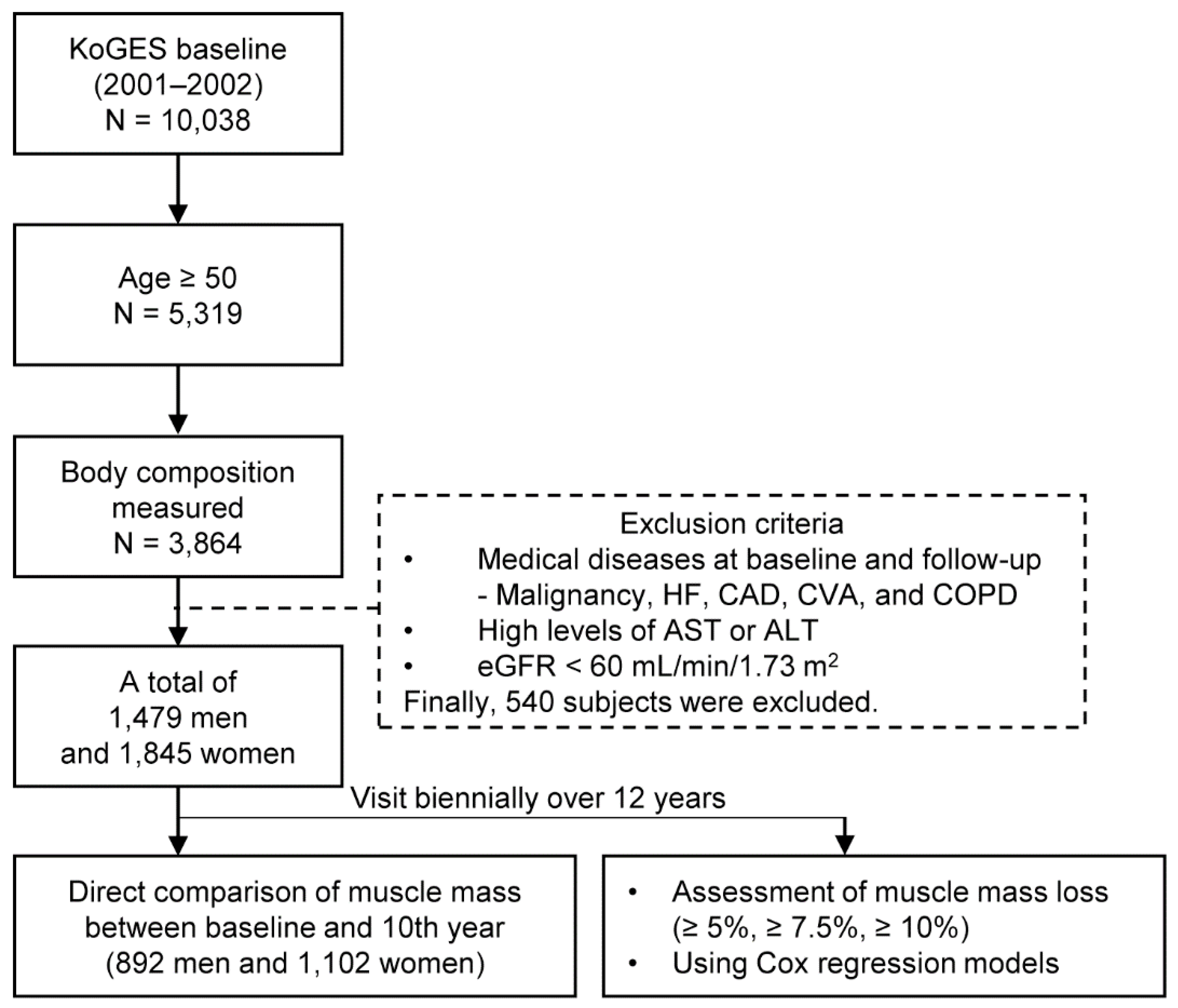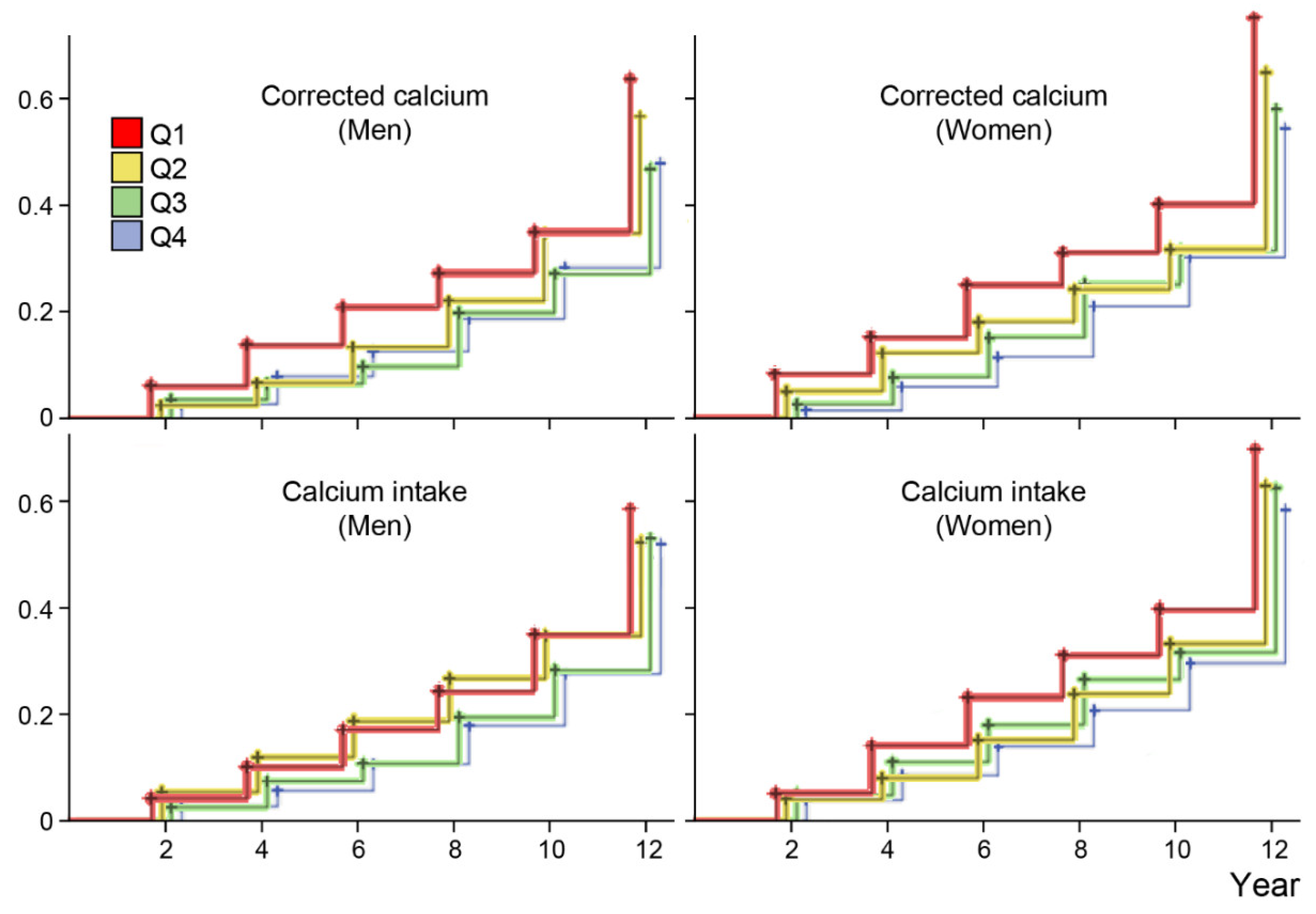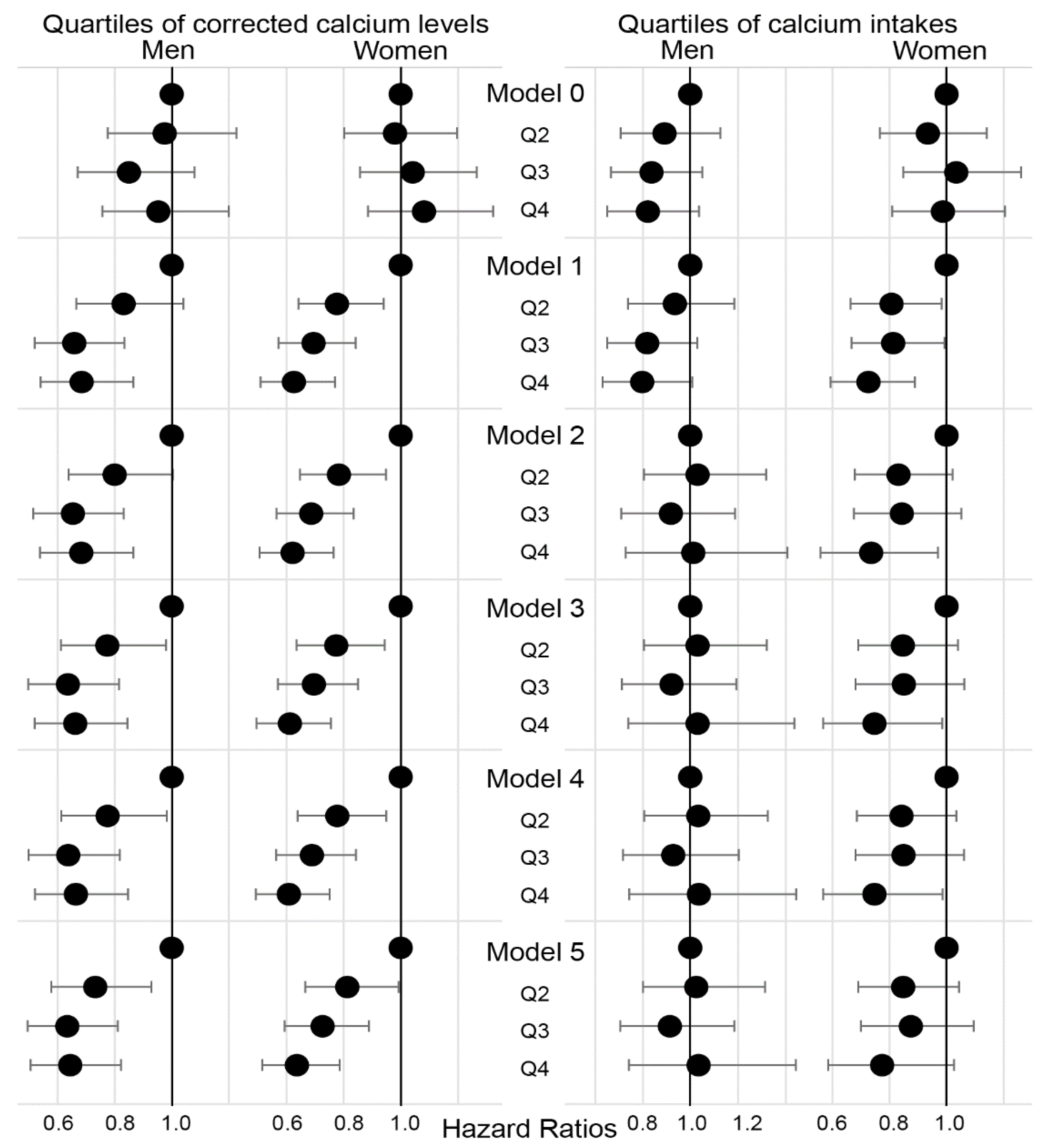Longitudinal Observation of Muscle Mass over 10 Years According to Serum Calcium Levels and Calcium Intake among Korean Adults Aged 50 and Older: The Korean Genome and Epidemiology Study
Abstract
1. Introduction
2. Subjects and Methods
2.1. Subjects
2.2. Medical History, Lifestyle Habits, and Anthropometric Measurements
2.3. Laboratory Tests
2.4. Food Frequency Questionnaire (FFQ)
2.5. Definition of Weight Loss and Muscle Loss
2.6. Statistical Analysis
3. Results
4. Discussion
5. Conclusions
Supplementary Materials
Author Contributions
Funding
Acknowledgments
Conflicts of Interest
References
- Delmonico, M.J.; Harris, T.B.; Visser, M.; Park, S.W.; Conroy, M.B.; Velasquez-Mieyer, P.; Boudreau, R.; Manini, T.M.; Nevitt, M.; Newman, A.B.; et al. Longitudinal study of muscle strength, quality, and adipose tissue infiltration. Am. J. Clin. Nutr. 2009, 90, 1579–1585. [Google Scholar] [CrossRef] [PubMed]
- Woo, J.; Leung, J.; Sham, A.; Kwok, T. Defining sarcopenia in terms of risk of physical limitations: A 5-year follow-up study of 3,153 chinese men and women. J. Am. Geriatr. Soc. 2009, 57, 2224–2231. [Google Scholar] [CrossRef]
- Tanimoto, Y.; Watanabe, M.; Sun, W.; Sugiura, Y.; Tsuda, Y.; Kimura, M.; Hayashida, I.; Kusabiraki, T.; Kono, K. Association between sarcopenia and higher-level functional capacity in daily living in community-dwelling elderly subjects in Japan. Arch. Gerontol. Geriatr. 2012, 55, e9–e13. [Google Scholar] [CrossRef]
- Cruz-Jentoft, A.J.; Baeyens, J.P.; Bauer, J.M.; Boirie, Y.; Cederholm, T.; Landi, F.; Martin, F.C.; Michel, J.P.; Rolland, Y.; Schneider, S.M.; et al. Sarcopenia: European consensus on definition and diagnosis: Report of the European Working Group on Sarcopenia in Older People. Age Ageing 2010, 39, 412–423. [Google Scholar] [CrossRef] [PubMed]
- Chen, L.K.; Liu, L.K.; Woo, J.; Assantachai, P.; Auyeung, T.W.; Bahyah, K.S.; Chou, M.Y.; Chen, L.Y.; Hsu, P.S.; Krairit, O.; et al. Sarcopenia in Asia: Consensus report of the Asian Working Group for Sarcopenia. J. Am. Med. Dir. Assoc. 2014, 15, 95–101. [Google Scholar] [CrossRef] [PubMed]
- Evans, W.J. Skeletal muscle loss: Cachexia, sarcopenia, and inactivity. Am. J. Clin. Nutr. 2010, 91, 1123S–1127S. [Google Scholar] [CrossRef]
- Insel, P.M.; Ross, D.; McMahon, K.; Bernstein, M. Nutrition, 6th ed.; Jones & Bartlett Learning: Burlington, MA, USA, 2017; pp. 485–491. [Google Scholar]
- Berchtold, M.W.; Brinkmeier, H.; Muntener, M. Calcium ion in skeletal muscle: Its crucial role for muscle function, plasticity, and disease. Physiol. Rev. 2000, 80, 1215–1265. [Google Scholar] [CrossRef] [PubMed]
- Van Dronkelaar, C.; Van Velzen, A.; Abdelrazek, M.; Van der Steen, A.; Weijs, P.J.M.; Tieland, M. Minerals and Sarcopenia; The Role of Calcium, Iron, Magnesium, Phosphorus, Potassium, Selenium, Sodium, and Zinc on Muscle Mass, Muscle Strength, and Physical Performance in Older Adults: A Systematic Review. J. Am. Med. Dir. Assoc. 2018, 19, 6–11. [Google Scholar] [CrossRef]
- Verlaan, S.; Aspray, T.J.; Bauer, J.M.; Cederholm, T.; Hemsworth, J.; Hill, T.R.; McPhee, J.S.; Piasecki, M.; Seal, C.; Sieber, C.C.; et al. Nutritional status, body composition, and quality of life in community-dwelling sarcopenic and non-sarcopenic older adults: A case-control study. Clin. Nutr. 2017, 36, 267–274. [Google Scholar] [CrossRef]
- Ter Borg, S.; de Groot, L.C.; Mijnarends, D.M.; de Vries, J.H.; Verlaan, S.; Meijboom, S.; Luiking, Y.C.; Schols, J.M. Differences in Nutrient Intake and Biochemical Nutrient Status Between Sarcopenic and Nonsarcopenic Older Adults-Results From the Maastricht Sarcopenia Study. J. Am. Med. Dir. Assoc. 2016, 17, 393–401. [Google Scholar] [CrossRef] [PubMed]
- Waters, D.L.; Wayne, S.J.; Andrieu, S.; Cesari, M.; Villareal, D.T.; Garry, P.; Vellas, B. Sexually dimorphic patterns of nutritional intake and eating behaviors in community-dwelling older adults with normal and slow gait speed. J. Nutr. Health Aging 2014, 18, 228–233. [Google Scholar] [CrossRef] [PubMed]
- Oh, C.; Jho, S.; No, J.K.; Kim, H.S. Body composition changes were related to nutrient intakes in elderly men but elderly women had a higher prevalence of sarcopenic obesity in a population of Korean adults. Nutr. Res. 2015, 35, 1–6. [Google Scholar] [CrossRef] [PubMed]
- Seo, M.H.; Kim, M.K.; Park, S.E.; Rhee, E.J.; Park, C.Y.; Lee, W.Y.; Baek, K.H.; Song, K.H.; Kang, M.I.; Oh, K.W. The association between daily calcium intake and sarcopenia in older, non-obese Korean adults: The fourth Korea National Health and Nutrition Examination Survey (KNHANES IV) 2009. Endocr. J. 2013, 60, 679–686. [Google Scholar] [CrossRef] [PubMed]
- Park, S.W.; Goodpaster, B.H.; Lee, J.S.; Kuller, L.H.; Boudreau, R.; de Rekeneire, N.; Harris, T.B.; Kritchevsky, S.; Tylavsky, F.A.; Nevitt, M.; et al. Excessive loss of skeletal muscle mass in older adults with type 2 diabetes. Diabetes Care 2009, 32, 1993–1997. [Google Scholar] [CrossRef] [PubMed]
- Lee, N.; Choi, C.J. Smoking and Diabetes as Predictive Factors of Accelerated Loss of Muscle Mass in Middle-Aged and Older Women: A Six-Year Retrospective Cohort Study. J. Womens Health 2019, 28, 1391–1398. [Google Scholar] [CrossRef]
- Abbatecola, A.M.; Chiodini, P.; Gallo, C.; Lakatta, E.; Sutton-Tyrrell, K.; Tylavsky, F.A.; Goodpaster, B.; de Rekeneire, N.; Schwartz, A.V.; Paolisso, G.; et al. Pulse wave velocity is associated with muscle mass decline: Health ABC study. Age 2012, 34, 469–478. [Google Scholar] [CrossRef]
- Kim, Y.; Han, B.G.; Ko, G.E.S.g. Cohort Profile: The Korean Genome and Epidemiology Study (KoGES) Consortium. Int. J. Epidemiol. 2017, 46, e20. [Google Scholar] [CrossRef]
- Lexell, J.; Taylor, C.C.; Sjostrom, M. What is the cause of the ageing atrophy? Total number, size and proportion of different fiber types studied in whole vastus lateralis muscle from 15- to 83-year-old men. J. Neurol. Sci. 1988, 84, 275–294. [Google Scholar] [CrossRef]
- Kim, D.; Kim, B.; Won, C.; Choi, H.; Kim, S.; Jang, M.; Shin, W. The Relationship Between Physical Activity and Risk of Cardiovascular Disease Among Hypertensive Persons: A Community-Based Prospective Study. Korean J. Fam. Pr. 2018, 8, 676–683. [Google Scholar] [CrossRef]
- Bushinsky, D.A.; Monk, R.D. Electrolyte quintet: Calcium. Lancet 1998, 352, 306–311. [Google Scholar] [CrossRef]
- Levey, A.S.; Stevens, L.A.; Schmid, C.H.; Zhang, Y.L.; Castro, A.F., 3rd; Feldman, H.I.; Kusek, J.W.; Eggers, P.; Van Lente, F.; Greene, T.; et al. A new equation to estimate glomerular filtration rate. Ann. Intern. Med. 2009, 150, 604–612. [Google Scholar] [CrossRef] [PubMed]
- Gaddey, H.L.; Holder, K. Unintentional weight loss in older adults. Am. Fam. Physician 2014, 89, 718–722. [Google Scholar] [PubMed]
- Tai, V.; Leung, W.; Grey, A.; Reid, I.R.; Bolland, M.J. Calcium intake and bone mineral density: Systematic review and meta-analysis. BMJ 2015, 351, h4183. [Google Scholar] [CrossRef] [PubMed]
- Tang, B.M.; Eslick, G.D.; Nowson, C.; Smith, C.; Bensoussan, A. Use of calcium or calcium in combination with vitamin D supplementation to prevent fractures and bone loss in people aged 50 years and older: A meta-analysis. Lancet 2007, 370, 657–666. [Google Scholar] [CrossRef]
- Bristow, S.M.; Horne, A.M.; Gamble, G.D.; Mihov, B.; Stewart, A.; Reid, I.R. Dietary Calcium Intake and Bone Loss Over 6 Years in Osteopenic Postmenopausal Women. J. Clin. Endocrinol. Metab. 2019, 104, 3576–3584. [Google Scholar] [CrossRef]
- Bolland, M.J.; Leung, W.; Tai, V.; Bastin, S.; Gamble, G.D.; Grey, A.; Reid, I.R. Calcium intake and risk of fracture: Systematic review. BMJ 2015, 351, h4580. [Google Scholar] [CrossRef]
- Rosenblum, J.L.; Castro, V.M.; Moore, C.E.; Kaplan, L.M. Calcium and vitamin D supplementation is associated with decreased abdominal visceral adipose tissue in overweight and obese adults. Am. J. Clin. Nutr. 2012, 95, 101–108. [Google Scholar] [CrossRef]
- Zhang, F.; Ye, J.; Zhu, X.; Wang, L.; Gao, P.; Shu, G.; Jiang, Q.; Wang, S. Anti-Obesity Effects of Dietary Calcium: The Evidence and Possible Mechanisms. Int. J. Mol. Sci. 2019, 20, 3072. [Google Scholar] [CrossRef]
- Major, G.C.; Alarie, F.P.; Dore, J.; Tremblay, A. Calcium plus vitamin D supplementation and fat mass loss in female very low-calcium consumers: Potential link with a calcium-specific appetite control. Br. J. Nutr. 2009, 101, 659–663. [Google Scholar] [CrossRef]
- Domiciano, D.S.; Figueiredo, C.P.; Lopes, J.B.; Caparbo, V.F.; Takayama, L.; Menezes, P.R.; Bonfa, E.; Pereira, R.M. Discriminating sarcopenia in community-dwelling older women with high frequency of overweight/obesity: The Sao Paulo Ageing & Health Study (SPAH). Osteoporos Int. 2013, 24, 595–603. [Google Scholar] [CrossRef]
- Bootman, M.D.; Collins, T.J.; Peppiatt, C.M.; Prothero, L.S.; MacKenzie, L.; De Smet, P.; Travers, M.; Tovey, S.C.; Seo, J.T.; Berridge, M.J.; et al. Calcium signaling—An overview. Semin. Cell Dev. Biol. 2001, 12, 3–10. [Google Scholar] [CrossRef] [PubMed]
- Dirks-Naylor, A.J.; Lennon-Edwards, S. The effects of vitamin D on skeletal muscle function and cellular signaling. J. Steroid Biochem. Mol. Biol. 2011, 125, 159–168. [Google Scholar] [CrossRef] [PubMed]
- Bischoff-Ferrari, H.A.; Borchers, M.; Gudat, F.; Durmuller, U.; Stahelin, H.B.; Dick, W. Vitamin D receptor expression in human muscle tissue decreases with age. J. Bone Miner. Res. 2004, 19, 265–269. [Google Scholar] [CrossRef] [PubMed]
- Joo, N.S.; Dawson-Hughes, B.; Kim, Y.S.; Oh, K.; Yeum, K.J. Impact of calcium and vitamin D insufficiencies on serum parathyroid hormone and bone mineral density: Analysis of the fourth and fifth Korea National Health and Nutrition Examination Survey (KNHANES IV-3, 2009 and KNHANES V-1, 2010). J. Bone Miner. Res. 2013, 28, 764–770. [Google Scholar] [CrossRef] [PubMed]
- Ministry of Health and Welfare. Dietary Reference Intakes for Koreans 2015; Ministry of Health and Welfare: Sejong, Korea, 2015.
- National Institute of Health. Dietary Supplement Fact Sheets: Calcium. Available online: https://ods.od.nih.gov/factsheets/Calcium-HealthProfessional/ (accessed on 9 May 2020).
- Zhu, J.; Xun, P.; Bae, J.C.; Kim, J.H.; Kim, D.J.; Yang, K.; He, K. Circulating calcium levels and the risk of type 2 diabetes: A systematic review and meta-analysis. Br. J. Nutr. 2019, 122, 376–387. [Google Scholar] [CrossRef]
- Bolland, M.J.; Avenell, A.; Baron, J.A.; Grey, A.; MacLennan, G.S.; Gamble, G.D.; Reid, I.R. Effect of calcium supplements on risk of myocardial infarction and cardiovascular events: Meta-analysis. BMJ 2010, 341, c3691. [Google Scholar] [CrossRef]
- Fielding, R.A.; Vellas, B.; Evans, W.J.; Bhasin, S.; Morley, J.E.; Newman, A.B.; Abellan van Kan, G.; Andrieu, S.; Bauer, J.; Breuille, D.; et al. Sarcopenia: An undiagnosed condition in older adults. Current consensus definition: Prevalence, etiology, and consequences. International working group on sarcopenia. J. Am. Med. Dir. Assoc. 2011, 12, 249–256. [Google Scholar] [CrossRef]
- Cruz-Jentoft, A.J.; Bahat, G.; Bauer, J.; Boirie, Y.; Bruyere, O.; Cederholm, T.; Cooper, C.; Landi, F.; Rolland, Y.; Sayer, A.A.; et al. Sarcopenia: Revised European consensus on definition and diagnosis. Age Ageing 2019, 48, 16–31. [Google Scholar] [CrossRef]
- Chien, M.Y.; Huang, T.Y.; Wu, Y.T. Prevalence of sarcopenia estimated using a bioelectrical impedance analysis prediction equation in community-dwelling elderly people in Taiwan. J. Am. Geriatr. Soc. 2008, 56, 1710–1715. [Google Scholar] [CrossRef]
- Kim, M.K.; Baek, K.H.; Song, K.H.; Kang, M., II; Park, C.Y.; Lee, W.Y.; Oh, K.W. Vitamin D deficiency is associated with sarcopenia in older Koreans, regardless of obesity: The Fourth Korea National Health and Nutrition Examination Surveys (KNHANES IV) 2009. J. Clin. Endocrinol. Metab. 2011, 96, 3250–3256. [Google Scholar] [CrossRef]
- Visser, M.; Deeg, D.J.; Lips, P.; Longitudinal Aging Study, A. Low vitamin D and high parathyroid hormone levels as determinants of loss of muscle strength and muscle mass (sarcopenia): The Longitudinal Aging Study Amsterdam. J. Clin. Endocrinol. Metab. 2003, 88, 5766–5772. [Google Scholar] [CrossRef] [PubMed]
- Rafferty, K.; Walters, G.; Heaney, R.P. Calcium fortificants: Overview and strategies for improving calcium nutriture of the U.S. population. J. Food Sci. 2007, 72, R152–R158. [Google Scholar] [CrossRef] [PubMed]
- Bristow, S.M.; Gamble, G.D.; Stewart, A.; Horne, L.; House, M.E.; Aati, O.; Mihov, B.; Horne, A.M.; Reid, I.R. Acute and 3-month effects of microcrystalline hydroxyapatite, calcium citrate and calcium carbonate on serum calcium and markers of bone turnover: A randomised controlled trial in postmenopausal women. Br. J. Nutr. 2014, 112, 1611–1620. [Google Scholar] [CrossRef] [PubMed]




| Men (N = 1479) | Women (N = 1845) | P | |
|---|---|---|---|
| Age (years) | 58.7 ± 5.7 | 59.1 ± 5.6 | 0.040 |
| Current smoker | 657 (44.4%) | 60 (3.3%) | <0.001 |
| Alcohol consumer | 235 (15.9%) | 17 (0.9%) | <0.001 |
| Physical activity | |||
| Mild | 450 (30.4%) | 669 (36.3%) | <0.001 |
| Moderate | 281 (19.0%) | 411 (22.3%) | |
| High | 748 (50.6%) | 765 (41.5%) | |
| Hypertension | 228 (15.4%) | 419 (22.7%) | <0.001 |
| Diabetes | 153 (10.3%) | 153 (8.3%) | 0.048 |
| Anthropometric measurement and body composition | |||
| Height (cm) | 165.1 ± 5.8 | 152.4 ± 5.4 | <0.001 |
| Body weight (kg) | 65.3 ± 9.7 | 58.6 ± 8.7 | <0.001 |
| Body mass index (kg/m2) | 23.9 ± 2.9 | 25.2 ± 3.3 | <0.001 |
| Muscle mass (kg) | 47.9 ± 6.0 | 36.8 ± 4.2 | <0.001 |
| Muscle/height2 (kg/m2) | 18.5 ± 1.6 | 16.8 ± 1.3 | <0.001 |
| Metabolic parameters and laboratory results | |||
| Systolic BP (mmHg) | 125.6 ± 17.8 | 126.6 ± 19.6 | 0.154 |
| Diastolic BP (mmHg) | 82.5 ± 10.6 | 81.2 ± 11.3 | <0.001 |
| Glucose (mmol/L) | 4.94 (4.61–5.44) | 4.83 (4.55–5.22) | <0.001 |
| Insulin (pmol/L) | 42.4 (32.6–58.3) | 50.0 (37.3–68.2) | <0.001 |
| HOMA2-IR | 0.80 (0.61–1.11) | 0.94 (0.69–1.27) | <0.001 |
| Total cholesterol (mmol/L) | 5.02 ± 0.93 | 5.37 ± 0.98 | <0.001 |
| HDL cholesterol (mmol/L) | 1.25 ± 0.31 | 1.30 ± 0.31 | <0.001 |
| Triglyceride (mmol/L) | 1.51 (1.04–2.24) | 1.47 (1.06–2.07) | 0.114 |
| Plasma renin activity (ng/mL/h) | 2.15 (1.09–3.80) | 1.21 (0.57–2.38) | <0.001 |
| eGFR (mL/min/1.73 m2) | 94.1 ± 18.4 | 87.3 ± 13.0 | <0.001 |
| Total protein (mmol/L) | 72.8 ± 4.5 | 72.7 ± 4.1 | 0.740 |
| Albumin (mmol/L) | 45.2 ± 3.0 | 44.4 ± 2.5 | <0.001 |
| Calcium (mmol/L) | 2.41 ± 0.12 | 2.41 ± 0.11 | 0.058 |
| Corrected calcium (mmol/L) | 2.37 ± 0.13 | 2.38 ± 0.12 | 0.080 |
| Food frequency questionnaire | |||
| Energy (kcal/d) | 2006.3 ± 690.7 | 1833.7 ± 664.8 | <0.001 |
| Carbohydrate (g/d) | 350.9 ± 111.0 | 336.0 ± 123.3 | <0.001 |
| Protein (g/d) | 68.4 ± 31.3 | 60.2 ± 25.8 | <0.001 |
| Fat (g/d) | 33.9 ± 22.5 | 25.6 ± 15.3 | <0.001 |
| Calcium (mg/d) | 468.5 ± 250.9 | 462.4 ± 266.8 | 0.505 |
© 2020 by the authors. Licensee MDPI, Basel, Switzerland. This article is an open access article distributed under the terms and conditions of the Creative Commons Attribution (CC BY) license (http://creativecommons.org/licenses/by/4.0/).
Share and Cite
Kim, Y.-S.; Hong, K.-W.; Han, K.; Park, Y.C.; Park, J.-M.; Kim, K.; Kim, B.-T. Longitudinal Observation of Muscle Mass over 10 Years According to Serum Calcium Levels and Calcium Intake among Korean Adults Aged 50 and Older: The Korean Genome and Epidemiology Study. Nutrients 2020, 12, 2856. https://doi.org/10.3390/nu12092856
Kim Y-S, Hong K-W, Han K, Park YC, Park J-M, Kim K, Kim B-T. Longitudinal Observation of Muscle Mass over 10 Years According to Serum Calcium Levels and Calcium Intake among Korean Adults Aged 50 and Older: The Korean Genome and Epidemiology Study. Nutrients. 2020; 12(9):2856. https://doi.org/10.3390/nu12092856
Chicago/Turabian StyleKim, Young-Sang, Kyung-Won Hong, Kunhee Han, Yon Chul Park, Jae-Min Park, Kwangyoon Kim, and Bom-Taeck Kim. 2020. "Longitudinal Observation of Muscle Mass over 10 Years According to Serum Calcium Levels and Calcium Intake among Korean Adults Aged 50 and Older: The Korean Genome and Epidemiology Study" Nutrients 12, no. 9: 2856. https://doi.org/10.3390/nu12092856
APA StyleKim, Y.-S., Hong, K.-W., Han, K., Park, Y. C., Park, J.-M., Kim, K., & Kim, B.-T. (2020). Longitudinal Observation of Muscle Mass over 10 Years According to Serum Calcium Levels and Calcium Intake among Korean Adults Aged 50 and Older: The Korean Genome and Epidemiology Study. Nutrients, 12(9), 2856. https://doi.org/10.3390/nu12092856





